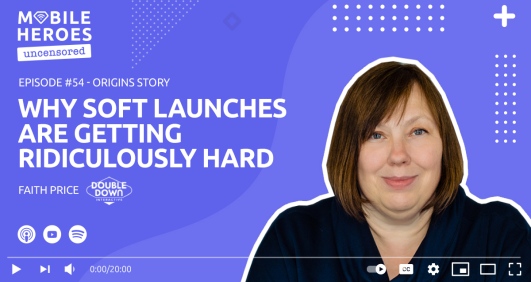Q&A with Faith
Faith Price manages user acquisition at DoubleDown Interactive as Director of Growth Marketing. Faith fell into marketing and games. She landed her first job at a small company marketing tabletop games. Faith then moved into e-commerce, managing affiliate programs for drugstore.com, Expedia and Hotels.com. She returned to her gaming roots in 2014 to join Big Fish Games. It was an exciting time in the industry, with F2P games and mobile UA still in their infancy. At DoubleDown Interactive, her team encompasses UA, ASO, SEO and Ad Monetization.
Read Faith's latest article: "Mastering App Store Optimization for the Mobile App Lifecycle"
In your own words, tell us about the app(s) that you manage?
DoubleDown Interactive (DDI) was an early pioneer in the mobile game space. We published one of the first social casino game, DoubleDown Casino, on Facebook in 2010. DoubleDown Casino continues to be our flagship app, providing users access to their favorite land-based slots and exclusive slots developed by in-house development teams.
Developing other popular casino titles like DoubleDown Classic Slots and DoubleDown Fort Knox, DDI is dedicated to providing unique player experiences across multiple genres. We recently launched Undead World: Hero Survival. In this idle zombie RPG game, players collect and upgrade heroes as they progress through the story of Cady, Connor, and other survivors fighting the undead hordes.
How did you get started in mobile marketing?
I originally joined Big Fish Games to manage the affiliate program for desktop games. After a few months, I was asked to take on soft-launching the new F2P mobile titles. This was an exciting opportunity to work with games in various categories and genres.
I learned many valuable lessons, including how difficult it is to make an investible game—only a handful of titles receive a worldwide release.
I also learned the importance of user acquisition, product and channel marketing, and creative and product design collaboration early in the game development process. At DDI, multiple teams participate in identifying the features that help drive user installs and engagement. This has helped facilitate more efficient marketing through the game lifecycle.
If you could start in mobile marketing again, would you do anything differently? Why and what would you do?
I was incredibly lucky—making the jump from desktop to mobile marketing in the early stages of the mobile game industry. It was a time when best practices were still being developed and optimization was done manually. I had an opportunity to learn many different aspects of mobile marketing from the ground up. I would not want to change any of that.
What do you like most about mobile marketing?
The two things I like most about mobile marketing are the ability to get accurate data and being at the forefront of what is next for marketing.
When I started in UA, I loved that nearly everything was trackable. It was great having a solid chain of cause and effect that you could influence with A/B testing. It also provided a better user experience since you were rewarded when you provided relevant and meaningful marketing to interested consumers.
While data attribution has become more challenging, mobile marketing is still leading the way by discovering what’s next for engaging with consumers. Gaming especially leads the way for both acquisition and retention. It’s exciting to be part of an industry that generates new ideas and innovations every year.
What do you see as the next big thing in mobile marketing?
The industry is constantly in flux, and there are a number of things that could be the next big thing. We hear more about the metaverse, NFTs and crypto. Netflix is testing games as part of their subscription model, and if they are successful, we could see investments from other streaming services. It all depends on consumer adoption. The initiative that becomes part of the general consumer consciousness will drive the next round of innovation and investment in marketing.
What strategies work best to convert installs into engaged app users?
Here are some best practices:
- Provide accurate content when marketing the product. The abundance of misleading ads in the space is frustrating to me as a consumer and marketer. Users download an app because it meets a need. If they open that app to find it completely different than expected, they will contribute to low retention and engagement rates.
- Make the onboarding experience simple with the ability to opt-out. Some users want to walk through how an app works, while others might already know or have a specific task in mind that they want to get to immediately. Build and test onboarding experiences for both types of users.
- Invest resources into engagement channels. It costs less to keep users engaged through social channels, email, loyalty programs, etc. than retargeting them after they have lapsed.
In the past year, what is one tip you can share which made the biggest performance difference for your UA strategy?
Consider how you can diversify your marketing efforts. Don’t rely on one platform, partner, or geo for installs. With the rapid changes in the industry, be flexible where you spend your budgets instead of being tied to past top-performing channels.
What advice can you offer marketers to successfully re-engage mobile app users?
The most important thing is understanding user behavior. How long does the typical user stay in your app? Once they lapse, what percentage will return on their own, and in what timeframe? What percentage will purchase without being re-targeted? Once you’re familiar with user behavior, start testing different iterations of lapsed time, win-back offers and creative.
What’s your top tip when it comes to mobile ad creative?
- Balance testing new ideas with iterations on top performers
- Provide a consistent feedback loop with the creative team on A/B tests and performance
- Make sure the ad layout is customized to meet partner best practices
- Check creative in the wild to ensure that ads are displayed correctly
What advice can you offer to help marketers combat mobile ad fraud?
Fighting fraud is more difficult after all the new attribution changes. Instead, we look at a mix of direct and indirect metrics. For example, look for changes in the key metrics (CTR, IR, Retention, Monetization) for both paid and organic installs, as these could be indicators of fraud in the supply.
What are your top 3 go-to resources for keeping up with the mobile ad tech industry?
Partner newsletters/blogs, Slack channels (ASO Stack/Mobile Heroes/Mobile Dev Memo) and Pocketgamer.biz.























